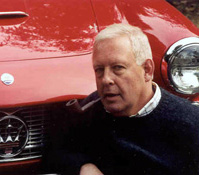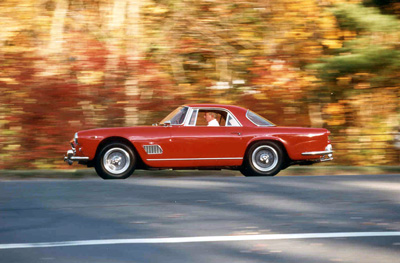January 7th, 2004
Interview with Willem Oosthoek
Author of "Birdcage to Supercage"

"Writing a
book is--must be--
a labor of love," says Oosthoek.
|
Most of us are avid readers, particularly of good, solid historical books which feature our favorite cars; the more detailed the better, with decent contemporary photos, chassis numbers, hardcore information that you can count on, preferably on nice stock and hardbound.
But few readers realize what goes into the making of such a book, and how difficult it is to find publishers. To help launch his latest book, "Birdcage to Supercage", we decided to ask Maserati expert Willem Oosthoek how he did it and what kind of problems he encountered.
What drives you to write books, love, money or prestige?
This has definitely been a labor of love. There is little money in it once you begin counting the hours involved. Starting originally to satisfy my own curiosity, I noticed that nobody knew the full story and that large parts of what was available were distorted, because of misinformation in Joel Finn's Maserati books of the seventies. So I decided the story had to be told.

Not content
to just write about Maseratis, Oosthoek also owns this superb Maserati 3500GT.
|
Did a publisher approach you or vice versa?
Based on my experience with motor racing publishers it is surprising that ANY interesting books are being published today or will be published in the future. Much to the dismay of a number of excellent historical authors I know, the publishers seem to be more interested in their bottom line then in serving the public with new and interesting subject matters. They prefer issuing the umpteenth Ferrari book, no matter how superficial, preferably with big, often rehashed pictures and little text. Picture books are definitely the trend these days.
Robert Bentley, David Bull, Haynes Publishing, Automobilia, Palawan Press, Motorbooks International: none had the guts to tackle a detailed book on rear-engined Birdcages. An outfit like Giorgio Nada turned me down and then proceeded with publishing the mediocre Maserati book by Maurizio Tabucchi, containing so many errors that it is insulting. It makes you wonder what kind of beancounters are running these companies. They certainly don't serve motor racing history.
Where and how did you find the photographs?
The main body of photos came from three people. Bob Tronolone is a good friend and his archives covered the West Coast races. I discovered Flip Schulke, a Time-Life photographer who did work for Car & Driver in the sixties, but who turned away from motor racing when his friend Bruce McLaren died. I tracked him down in Florida and we became friends. His work covered Sebring and Nassau. Egon Hofer in Austria owns one of the Tipo 63 cars and he has excellent archives with negatives taken by Pete Coltrin. This covered the factory and Italian testing photos. Bernard Cahier came to the rescue for the Nurburgring, and Geoffrey Goddard and my late friend Henri Beroul for Le Mans.
But photos of some races were very hard to find. Bill Green helped me with Watkins Glen.The Bridgehampton photos came from the Ludvigsen Collection in London and European friends like Michel Bollee, Walter Baumer and Andre Pibarot helped me with material from their own collections. Road America was a problem and one of the photographers, tracked down because his work appeared in the RA programs of the sixties, conceded that he had thrown it all away!
How did you manage the interviews?
As the historian of The Maserati Club I interviewed a lot of the Maserati drivers and car owners in person, while on business trips for my regular job in international banking. Even before I decided to do the book, I felt the urgency to interview the people involved, as they were not going to be around forever. If not done while I had the opportunity, many fascinating racing stories would be lost. I interviewed team owners Joe Lubin in Los Angeles and Frank Harrison in Chattanooga. I sat down with drivers like Bill Kimberly in the DC area, Jim Jeffords in Milwaukee, Bill Krause in Los Angeles and Dick Thompson in West Palm Beach. Augie Pabst was done by phone and at Monterey, and Briggs Cunningham by phone. Briggs was very pleasant and polite, but he had no real information to convey even in 1990, when he was still in good health. I also tracked down the 96-year old sister of the late Maserati France owner John Simone. She lived in Geneva, Switzerland and provided valuable information about John's life, with rare photographs. Factory assistance was non-existent due to lack of detailed archives, although Ermanno Cozza was always eager to help.
What kind of problems did you encounter?
Apart from the problems in tracking down historical photos and a publisher, the main problem was that of solving the jigsaw puzzle of the history of these ten cars. Most of the owners had no clue, neither did the museum curators. Factory records were incomplete and Birdcage designer Ing. Alfieri had not really been involved in the preparation of these cars. Chief tester Bertocchi would have been an excellent source, but he died before I even started my research.
Were the owners helpful?
Most of them were, with the exception of Peter Kaus who never responded. This was probably because -in a letter published by Classic & Sports Car magazine- I called his Tipo 151 a replica, which did not please him a bit. I was also hired as an expert by the Artom family, when they threatened Bruce McCaw with a lawsuit, about which Tipo 63 was the real 4th place Le Mans car in 1961. In the end the McCaw people retracted their claim. All of the cars have survived, with one being used up in the construction of the Tipo 65. Some of them have undergone marvelous restoration, but a number of the engines - 4-cylinder and V12 units - are not correct, let alone original.



